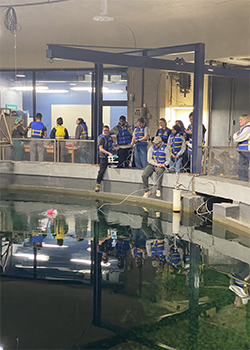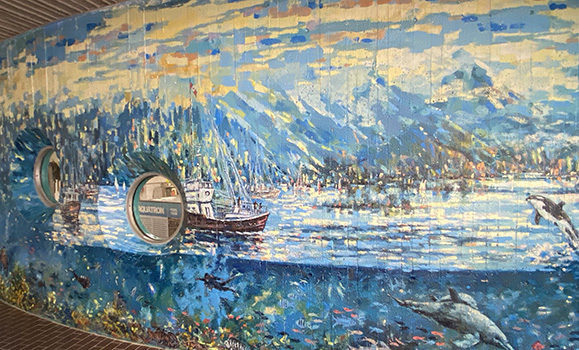Visitors passing through the second floor of DalhousieŌĆÖs Life Sciences Centre in search of Tim Hortons or a classroom may be unaware that CanadaŌĆÖs largest university aquatic research facility is seemingly hiding in plain sight behind a colourful hand-painted mural of vibrant ocean life.
ŌĆ£I remember being a first-year student coming in and looking through the windows of the Aquatron and thinking, ŌĆśI really want to see it,ŌĆÖŌĆØ says Emily McLean (BScŌĆÖ24), a recent honours Biology graduate. ŌĆ£To have the opportunity as a student to actually be able to do that is a pretty cool thing Dal can offer.ŌĆØ
Dr. Derek Tittensor, a professor in the Department of Biology and the Jarislowsky Chair in Marine Ecosystem Forecasting, teaches a third-year conservation biology course that discusses endangered species and how to protect and conserve them. Every year, he gives students in the course a tour of the facility.╠²

ŌĆ£Showing students the work that can happen in the Aquatron is eye-opening for them in realizing that this kind of applied conservation is going on right here in our backyard,ŌĆØ says Dr. Tittensor, who highlights the Atlantic Whitefish, a critically endangered species found in Nova Scotia that has effectively been brought back from extinction in the Aquatron.
ŌĆ£There is nothing like seeing conservation principles, concepts and ideas put into practice first-hand,ŌĆØ says Dr. Tittensor.
Shown right: Students in the Aquatron ealier this year.
In future classes, he hopes to showcase the experimental work being done by his on and growing and restoring seagrass. Seagrasses are efficient carbon sinks and may store up to 10 per cent of the worldŌĆÖs blue carbon every year. Found in Atlantic Canada, eelgrass is a unique species of seagrass that lives completely underwater, and research efforts are underway to understand why eelgrass is disappearing and how it can be restored.
ŌĆ£This coming year, we are planning to test growing eelgrass in the Aquatron for the first time,ŌĆØ he says. ŌĆ£We have also explored how different temperatures and water salinites affect eelgrass seed germination rates to help maximize our pilipili┬■╗Ł when restoring Nova Scotian eelgrass meadows.ŌĆØ
Putting conservation into action
Emily, who will begin a Master of Environmental Studies at Dal this fall, says the semester-long project in Dr. TittensorŌĆÖs conservation biology class allowed her to pursue one of her passions: advocating for the protection of pollinators that are essential to plant health and reproduction.╠²
ŌĆ£Having the time to carry out a project like that was my favourite part of the course,ŌĆØ she says, ŌĆ£because something actually came from it.ŌĆØ In December 2023, her efforts to improve conditions for pollinators helped Dal become the 20th Bee Campus in Canada. She also hopes Halifax will one day become an official , having lobbied city council to apply for the designation in fall 2022.╠²
While her conservation efforts largely took place on land,╠²Emily got a taste of the Aquatron by participating in the ŌĆ£Deep Dive into ROVsŌĆØ (remotely operated vehicles) event from SURGE, DeepSense, the Ocean Tracking Network, and ShiftKey Labs. Over a weekend in January 2023, teams of four to five Dal students from various disciplines built an ROV and tested its amphibious capabilities by deploying it in the AquatronŌĆÖs pool tank, which simulates a body of water.
ŌĆ£It was really cool to build the ROV from scratch and then have access to the pool just steps away from the workshop to see how it operates underwater,ŌĆØ╠²Emily said of the experience.
The ROV event represented the second installment of a workshop developed by Laura deGelleke, a senior instructor in the Department of Oceanography who uses the Aquatron in her Tools & Concepts in Ocean Sciences course to conduct a mesocosm experiment.
ŌĆ£The Aquatron staff, especially Jim Eddington, are awesome in helping us set up,ŌĆØ deGelleke says. ŌĆ£The Aquatron also helps us acclimatize mussels for filter feeding experiments in their flow through the tanks, and we make regular use of a seawater tap in the lab that brings in seawater directly from the Northwest Arm. The Aquatron really is a great resource!ŌĆØ
ŌĆśA world-class facilityŌĆÖ
Whether being used by researchers or students, the Aquatron shows no signs of ceasing to be a valuable educational tool as it approaches its 50th birthday.
ŌĆ£There is no doubt that the Aquatron is a world-class facility for experimental marine biology research,ŌĆØ says Dr. Tittensor. ŌĆ£IŌĆÖve been fortunate enough to travel to some prominent marine research facilities around the world, and the Aquatron is up there for its sheer scale and the unparalleled opportunities that it provides scientists to run experiments and conduct research.╠²
ŌĆ£We are very, very fortunate to have this facility available to us as researchers and, in my case, as a conservation scientist.ŌĆØ

A colourful mural with porthole windows that provide a glimpse into the Aquatron. (Kenneth Conrad photo)

